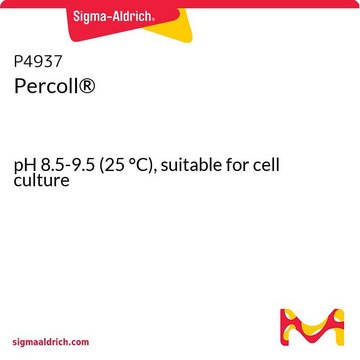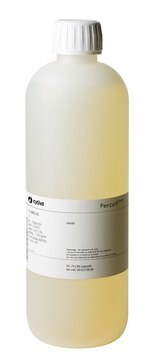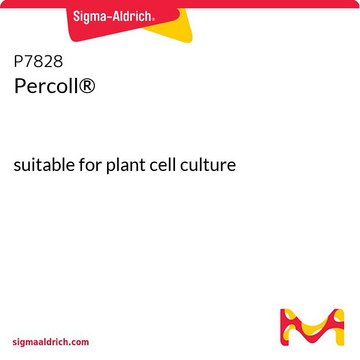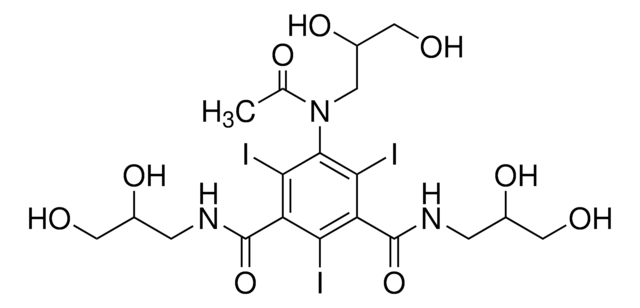P1644
Percoll®
pH 8.5-9.5 (20 °C)
Synonym(s):
Percoll Density Gradient Media
Sign Into View Organizational & Contract Pricing
All Photos(1)
About This Item
Recommended Products
sterility
aseptically filled
Quality Level
form
colloidal ((Colloidal solution of silica coated with polyvinylpyrrolidone (PVP)) )
technique(s)
cell culture | mammalian: suitable
color
clear colorless to faint yellow
pH
8.5-9.5 (20 °C)
application(s)
hematology
histology
storage temp.
2-8°C
Looking for similar products? Visit Product Comparison Guide
General description
Percoll® is a classic medium for density gradient centrifugation of cells, viruses, and subcellular particles. Percoll consists of colloidal silica particles of 15–30 nm diameter (23% w/w in water), which have been coated with polyvinylpyrrolidone (PVP). The PVP coating renders the product completely non-toxic and ideal for use with biological materials.
Application
Percoll consists of colloidal silica particles of 15-30 nm diameter (23% w/w in water) which have been coated with polyvinylpyrrolidone (PVP). It is used in cell separation and organelle isolation.
Percoll consists of colloidal silica particles of 15-30 nm diameter (23% w/w in water) which have been coated with polyvinylpyrrolidone (PVP). It is used to establish non-toxic low viscosity, low osmolarity density gradients that can be used to isolate cells, organelles and viruses. It has been used to separate inner and outer membrane vesicles from E. coli. Percoll is isosmotic throughout the gradient, non-toxic, and is easily removed from the purified materials.
Percoll® has been used in sperm preparation to study the energy requirements of bovine embryos.
Legal Information
Percoll is a registered trademark of Cytiva
related product
Product No.
Description
Pricing
Storage Class Code
10 - Combustible liquids
WGK
WGK 3
Flash Point(F)
Not applicable
Flash Point(C)
Not applicable
Personal Protective Equipment
dust mask type N95 (US), Eyeshields, Gloves
Choose from one of the most recent versions:
Already Own This Product?
Find documentation for the products that you have recently purchased in the Document Library.
Customers Also Viewed
Rajasree Sreedharan et al.
Kidney international, 86(3), 515-524 (2014-05-09)
Inducible heat shock proteins (HSPs), regulated by heat shock factor-1 (HSF-1), protect against renal cell injury in vitro. To determine whether HSPs ameliorate ischemic renal injury in vivo, HSF-1 functional knockout mice (HSF-KO) were compared with wild-type mice following bilateral
T Hirano et al.
The Journal of cell biology, 106(4), 1171-1183 (1988-04-01)
A temperature-sensitive mutant nuc2-663 of the fission yeast Schizosaccharomyces pombe specifically blocks mitotic spindle elongation at restrictive temperature so that nuclei in arrested cells contain a short uniform spindle (approximately 3-micron long), which runs through a metaphase plate-like structure consisting
Guilherme D Melo et al.
Scientific reports, 7(1), 8454-8454 (2017-08-18)
Visceral leishmaniasis (VL) is a systemic disease with multifaceted clinical manifestations, including neurological signs, however, the involvement of the nervous system during VL is underestimated. Accordingly, we investigated both brain infection and inflammation in a mouse model of VL. Using
Tanja Zöller et al.
International journal of molecular sciences, 19(3) (2018-03-02)
Microglia are the resident immune cells of the central nervous system (CNS) and participate in physiological and pathological processes. Their unique developmental nature suggests age-dependent structural and functional impairments that might contribute to neurodegenerative diseases. In the present study, we
R Hovius et al.
Biochimica et biophysica acta, 1021(2), 217-226 (1990-01-29)
Rat liver mitochondria were isolated by a combination of differential and Percoll gradient centrifugation, resulting in a highly pure and intact preparation, as assessed by marker enzyme analysis, latency of cytochrome-c oxidase, respiratory control index and electron microscopy. Two different
Our team of scientists has experience in all areas of research including Life Science, Material Science, Chemical Synthesis, Chromatography, Analytical and many others.
Contact Technical Service










